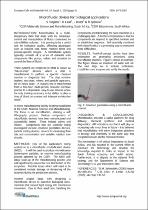JavaScript is disabled for your browser. Some features of this site may not work without it.
- ResearchSpace
- →
- Research Publications/Outputs
- →
- Journal Articles
- →
- View Item
| dc.contributor.author |
Potgieter, S

|
|
| dc.contributor.author |
Land, K

|
|
| dc.contributor.author |
Kotze, L

|
|
| dc.contributor.author |
Sparrow, R

|
|
| dc.date.accessioned | 2010-02-09T12:42:55Z | |
| dc.date.available | 2010-02-09T12:42:55Z | |
| dc.date.issued | 2010 | |
| dc.identifier.citation | Potgieter, S, Land, K et al. 2010. Microfluidic devices for biological applications. European Cells and Materials, Vol.19(Supplement 1), pp 3 | en |
| dc.identifier.issn | 1473-2262 | |
| dc.identifier.uri | http://hdl.handle.net/10204/3936 | |
| dc.identifier.uri | http://www.ecmjournal.org/ | en |
| dc.description | Copyright of this article belongs to the authors. | en |
| dc.description.abstract | Microfluidics is a multi-disciplinary field that deals with the behaviour, control and manipulation of fluids constrained to sub-millilitre volumes. It is proving to be a useful tool for biological studies, affording advantages such as reduced cost, faster reaction times and process-specific designs. A microfluidic system typically consists of a series of channels with components like pumps, valves and actuators to control the flow of fluids. One of the applications being worked on is a microfluidic emulsification device (MED). It will be used to produce monodisperse Spherezyme particles, an enzyme manufacturing process patented by the CSIR. The MED will allow scale-up of the manufacturing process and will significantly reduce the size distribution of the enzynmes. Possible issues which will need to be considered include damage or denaturing of the enzymes during the production process. | en |
| dc.language.iso | en | en |
| dc.publisher | European Cells & Materials Ltd | en |
| dc.subject | Microfluidic emulsification devices | en |
| dc.subject | MED | en |
| dc.subject | Microfluidics | en |
| dc.subject | Lab-on-chip | en |
| dc.subject | Spherezyme | en |
| dc.subject | Enzymes | en |
| dc.title | Microfluidic devices for biological applications | en |
| dc.type | Article | en |
| dc.identifier.apacitation | Potgieter, S., Land, K., Kotze, L., & Sparrow, R. (2010). Microfluidic devices for biological applications. http://hdl.handle.net/10204/3936 | en_ZA |
| dc.identifier.chicagocitation | Potgieter, S, K Land, L Kotze, and R Sparrow "Microfluidic devices for biological applications." (2010) http://hdl.handle.net/10204/3936 | en_ZA |
| dc.identifier.vancouvercitation | Potgieter S, Land K, Kotze L, Sparrow R. Microfluidic devices for biological applications. 2010; http://hdl.handle.net/10204/3936. | en_ZA |
| dc.identifier.ris | TY - Article AU - Potgieter, S AU - Land, K AU - Kotze, L AU - Sparrow, R AB - Microfluidics is a multi-disciplinary field that deals with the behaviour, control and manipulation of fluids constrained to sub-millilitre volumes. It is proving to be a useful tool for biological studies, affording advantages such as reduced cost, faster reaction times and process-specific designs. A microfluidic system typically consists of a series of channels with components like pumps, valves and actuators to control the flow of fluids. One of the applications being worked on is a microfluidic emulsification device (MED). It will be used to produce monodisperse Spherezyme particles, an enzyme manufacturing process patented by the CSIR. The MED will allow scale-up of the manufacturing process and will significantly reduce the size distribution of the enzynmes. Possible issues which will need to be considered include damage or denaturing of the enzymes during the production process. DA - 2010 DB - ResearchSpace DP - CSIR KW - Microfluidic emulsification devices KW - MED KW - Microfluidics KW - Lab-on-chip KW - Spherezyme KW - Enzymes LK - https://researchspace.csir.co.za PY - 2010 SM - 1473-2262 T1 - Microfluidic devices for biological applications TI - Microfluidic devices for biological applications UR - http://hdl.handle.net/10204/3936 ER - | en_ZA |






